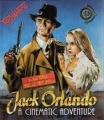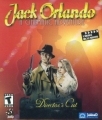Jack Orlando: A Cinematic Adventure
First posted on 01 September 2013. Last updated on 01 September 2013.

|
| Jack drinks up at a local bar. |

|
| Jack lies unconscious beside the murder victim in an alley. |

|
| Jack finds a clue in a matchbox. |

|
| Jack discovers a hidden catacomb. |

|
| Jack's coat doubles as the inventory. |
Jack Orlando: A Cinematic Adventure (Director's Cut)
Released in 2001, the Director's Cut version of Jack Orlando: A Cinematic Adventure includes more red herrings, a revised inventory, and an additional mode of play that alters some of the game's dialogs and puzzles. Otherwise, the re-release is identical to the original.
Set just after the end of prohibition in 1933 somewhere in America (likely Chicago), Jack Orlando: A Cinematic Adventure starts out as a rather stereotypical detective story. Jack Orlando, the titular character, wears a coat with a matching fedora and carries a colt revolver. He has also recently started searching for the meaning of life in the bottom of a few whiskey bottles—an ironic choice given his old job of tracking down bootleggers and report them, a job that has made him quite a few enemies. Jack is also a bit depressed by his sinking career, seemingly both a result of and a reason for his growing drinking problem.
The story begins with Jack witnessing a murder in an alley. He is knocked unconscious there, and the police officers who later find him are quick to jump to the idiotic conclusion that Jack must be the murderer. Jack is briefly detained and then given 48 hours to solve the murder to clear his name. Searching the crime scene and the surrounding areas, Jack finds a few leads which he decides to pursue. With time running out, Jack must solve the most important case in his life.
The game features a rich soundtrack of jazz music mixed with a touch of classic noir, composed by Harold Faltermeyer (best known as the composer for Top Gun and Beverly Hills Cop). There is just enough variation in the score so that listening to it does not get tiresome. The game also features a large cast of voice actors. Unlike the music, however, the voice acting is campy and mostly abysmal. For example, among the first voices heard in the game is that of a woman screaming for help when she discovers the murder in the alley. The acting is so horrible that you wonder if the actress has done it on purpose. On the other hand, Andrew Culjack who voices Jack gives the hardboiled detective a decent and characteristic sound. Other characters vary from annoying and unrealistic to overplayed and stereotyped impressions. The dialogs themselves are also meaningless more often than not, which may be partly as a result of poor English localization.
The characters are drawn in realistic proportions but with a cartoonish style using cel-shaded animations. The backgrounds, of which there are plenty, are much more realistically drawn. They feature a lot of details and are partly animated (for example, walking characters, a running cat, or a piece of paper blowing in the wind). The game is set in quite a large city, with lots of characters for you to interact with at many locations. Most of these characters are, however, just strangers on the street, patrons at bars, or some locals who are there to populate a scene but play no part in the story. Similarly, there are a lot of objects for you to pick up that serve no purpose to the story. It is not uncommon to have richly detailed scenes in a game, but it is a bit unusual that these details are also hotspots which you can explore in this game.
If you are fan of a particular story setting, you will most likely appreciate a richly detailed world that helps to immerse you into the story. However, when the story chooses to take on an overly realistic portrayal of a recent historical period, I personally find it to be a bit dull. Talking to a bum on the street is not rewarding by itself. In most cases, talking to most ancillary characters in this game is a wasted effort since they do not help to advance the story.
An inherent absurdity in the logic of an adventure game is that you have to grab every object that the game allows. You may make no sense of it at first, but often you will find that the object serves some purpose later on. This has become the standard mechanic used by adventure games. Jack Orlando: A Cinematic Adventure tries to take a more realistic approach to this mechanic, in which trash objects can be picked up that serve no purpose at all. Upon reaching the end parts of the game, you may find yourself having collected more than 50 unusable items in the inventory. It can be rather confusing to manage the inventory of this size, as it takes time to find relevant objects for use. As well, it is not clear which objects are usable and which objects are trash. Several of the puzzles also have strange solutions. For example, at some point in the game, you will need to find a piece of wire on the street and use it on a workbench to form a key. You will then need to use this key to open a door that you have no idea where it leads to.
Often, the objectives tasked to you by the game are vague. When the game starts, you are immediately stuck without really knowing what to do except to "find out who framed Jack Orlando". Wandering around in a world full of red herrings, it is easy for you to lose focus and not really know what is relevant and what is not. Sometimes, Jack voices that he needs a particular object but fails to hint at you on what purpose the object is for. For example, early in the game, Jack is obsessed with getting a crank, but the purpose for the object is clear only until after he obtains it.
Re-released in 2001 as Jack Orlando: A Cinematic Adventure (Director's Cut), this version features 2 difficulty modes not found in the original version released in 1997. The easy mode is a slightly shorter version of the game, in which Jack cannot die or get stuck and the puzzles do not have a time limit. It also strips down a few of the puzzles and scenes. The difference is noticeable even from the very beginning. In the first scene, after Jack is suspected as being the murderer, he is immediately remanded into custody. In the easy mode, he will be let go at the scene after a short dialog. In the normal mode, he will instead be taken to the police station and have to plead for his release there.
Another odd change from the original version is the inventory. To open Jack's coat, where he keeps his inventory, can only be accessed by using the F1 key. I find it strange that the inventory cannot be accessed by using the mouse at all. As well, there is not possible to examine objects already in the inventory. Clicking on them will only select them so they can be used. By comparison, all other actions can be selected by right-clicking the mouse, wherein a pop-up gives the available options. These options include an arrow for walking and talking to characters, a magnifying glass for examining objects, a hand for picking up objects, a fist for punching or breaking, and a gun, if obtained, to shoot objects or threaten other characters.
The selected action displays a little animation when hovering over an hotspot that can be interacted with. For example, the hand cursor displays a grabbing animation when pointing over a object that can be picked up. It is, however, confusing when some animations are played just by moving the cursor, giving a false impression that there is a small hidden object with which you can interact. Some pixel hunting is necessary since some objects are rather small. They usually stand out from the background but at times are easy to miss.
Most characters that you encounter can be engaged in conversations. Topics are often related to the case ("Have you seen anything suspicious tonight?"). Yet, most of them will answer no, thus revealing no relevant information to Jack. In fact, the game can be solved by just speaking to a fraction of the characters. Money can be given to most characters as bribes, even though you may not get any lead in return. Fortunately, money can be procured in several ways in the game, so there is no harm in giving some away. It is possible to hit a dead end in this game. A few puzzles have alternate solutions. For example, you can pay a fee to gain entrance to a bar or find a backdoor to sneak into it.
The game is unusual for featuring a large number of insignificant locations. An example is the hidden catacomb beneath the city. There are about 10 scenes dedicated to this treasure chamber, with a lot of hotspots, including many statues, a library, a pharaoh mask, and some references to the Knight Templar. Yet, the only object you truly need to pick up is as trivial as a poker chip! Further, it makes no sense that a large catacomb somehow remains entirely undiscovered beneath a house in a major city in America. Even so, the catacomb serves no purpose to the case whatsoever and is not even mentioned later in the game. It appears as if the developer has forgotten to fill the catacomb with puzzles after having taken the time to create it.
For adventure games, it is often said that older games are much harder to play than newer games. This game is certainly a proof of this maxim. With so many redundant objects, characters, and even locations, it takes a lot of time to find solutions to all of the puzzles in the game. Additionally, many of these puzzles are a bit too farfetched. It is also strange that the characters cannot even give you a little hint on what they want when you speak to them. For example, at a particular point, Jack needs to have his car fixed in a garage. The car mechanic who is doing the repair does not want money as payment. Rather, you have to remember some other character you have met elsewhere mentions that the car mechanic is fond of whiskey. It is only after Jack offers the car mechanic a bottle of whiskey that he can get his car keys back. The game is full of situations where it is vital to remember information gained at some location to advance in another location that is otherwise unrelated.
Jack Orlando: A Cinematic Adventure is by no means a rushed game. It features many detailed locations and a large cast of characters that together form a vivid world. However, these added details soon turn into tedious exploration that distract from the main storytelling and make the game unnecessary difficult. In all, if you enjoy a really hard challenge and are not easily frustrated by demanding puzzles, then you may like this game for nostalgia of a bygone era for the genre.

